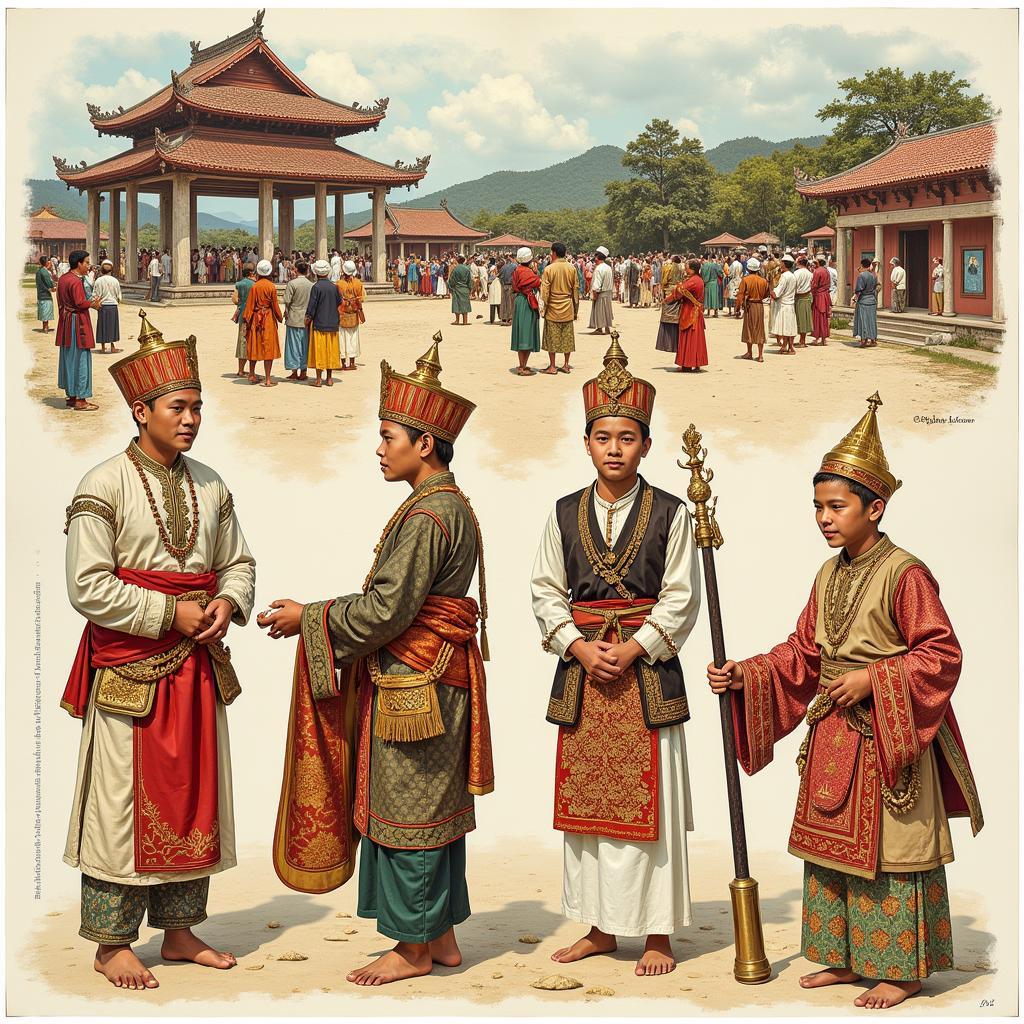Southeast Asia’s vibrant tapestry of cultures and histories is reflected in the diverse nationalities of its 10 member states. This guide explores the 10 Asean Countries Nationality, delving into the unique identities that shape this dynamic region. Understanding the distinct characteristics of each nationality provides a deeper appreciation for the rich cultural heritage of ASEAN.
Exploring the Nationalities of the 10 ASEAN Countries
The Association of Southeast Asian Nations (ASEAN) comprises 10 countries: Brunei, Cambodia, Indonesia, Laos, Malaysia, Myanmar, the Philippines, Singapore, Thailand, and Vietnam. Each nation boasts a unique identity, shaped by its history, traditions, and interactions within the region and the world. Let’s embark on a journey to discover the fascinating nuances of each 10 ASEAN countries nationality.
Brunei: The Abode of Peace
Bruneians, citizens of the small but wealthy nation of Brunei Darussalam, are known for their strong adherence to Islamic traditions and Malay culture. Their nationality is deeply rooted in their royal heritage and the country’s rich history as a prominent maritime trading center.
 Bruneian Culture and Traditions
Bruneian Culture and Traditions
Cambodia: The Land of the Khmer
Cambodian nationality is intrinsically linked to the Khmer Empire, a powerful kingdom that once dominated much of Southeast Asia. Cambodians are proud of their ancient heritage, evident in the magnificent temples of Angkor Wat and their vibrant artistic traditions.
Indonesia: The Emerald of the Equator
With over 17,000 islands and hundreds of ethnic groups, Indonesian nationality is a complex and fascinating mosaic. From the bustling streets of Jakarta to the remote villages of Papua, Indonesians share a common bond of national pride and a rich cultural heritage.
Laos: The Land of a Million Elephants
Laotian nationality is characterized by a gentle and laid-back approach to life, deeply influenced by Theravada Buddhism. Laotians are known for their strong community ties and their rich artistic traditions, particularly in weaving and woodcarving.
Malaysia: Truly Asia
Malaysian nationality is a blend of Malay, Chinese, Indian, and indigenous cultures, reflecting the country’s diverse population. This multiculturalism is celebrated as a source of strength and is reflected in the country’s vibrant arts, cuisine, and festivals.
Myanmar: The Golden Land
Myanmar’s nationality is shaped by its unique history and diverse ethnic groups, including the Bamar, Shan, Karen, and Rakhine. The country’s rich Buddhist traditions and its stunning landscapes contribute to a distinct sense of national identity.
The Philippines: The Pearl of the Orient Seas
Filipino nationality is known for its warmth, hospitality, and resilience. Influenced by Spanish and American colonization, Filipino culture is a unique blend of East and West, reflected in their language, music, and cuisine.
Singapore: The Lion City
Singaporean nationality is characterized by its multiculturalism, efficiency, and forward-thinking approach. As a global hub for trade and innovation, Singaporeans are known for their pragmatism and their commitment to excellence.
Thailand: The Land of Smiles
Thai nationality is deeply rooted in Theravada Buddhism and the country’s long history of independence. Thais are known for their gracious hospitality, their vibrant festivals, and their reverence for the monarchy.
Vietnam: The Ascending Dragon
Vietnamese nationality is characterized by resilience, hard work, and a strong sense of national pride. Vietnamese culture is deeply influenced by Confucianism and its long history of resisting foreign occupation.
What are the Commonalities and Differences Among ASEAN Nationalities?
While each ASEAN nationality is unique, several common threads weave them together. A shared history of colonialism, a predominantly tropical climate, and a focus on family and community values are some of the commonalities. However, differences in language, religion, and political systems also contribute to the rich tapestry of ASEAN identities. asean basketball league players from different countries showcase the diversity and shared passion for sports in the region.
Frequently Asked Questions about ASEAN Nationalities
- What is the official language of ASEAN? English is the official working language of ASEAN.
- How many ethnic groups are there in ASEAN? ASEAN is home to hundreds of ethnic groups, each with its own distinct language and culture.
- What are some of the major religions practiced in ASEAN? Buddhism, Islam, Christianity, and Hinduism are among the major religions practiced in ASEAN.
- What is the ASEAN Economic Community (AEC)? The AEC aims to create a single market and production base for the free flow of goods, services, investment, capital, and skilled labor within ASEAN.
- How can I learn more about ASEAN cultures? ASE Arrivals and ASEAN Air Travel provide insights into tourism and travel within the region, offering a glimpse into different cultures.
Conclusion
Understanding the 10 ASEAN countries nationality is crucial for appreciating the diversity and richness of this dynamic region. From the Abode of Peace to the Ascending Dragon, each nation contributes its unique thread to the vibrant tapestry of Southeast Asia. Exploring these distinct identities fosters greater understanding and cooperation within ASEAN and beyond. For those seeking information regarding labor regulations, ASE Department of Labor Claims can be a valuable resource. Asea locations can help you understand the geographic distribution of this diverse region.
For any assistance, please contact us at Phone: 0369020373, Email: [email protected], or visit us at Thôn Ngọc Liễn, Hiệp Hòa, Bắc Giang, Việt Nam. Our customer service team is available 24/7.

